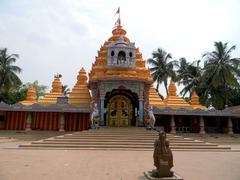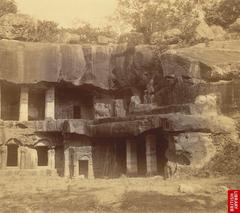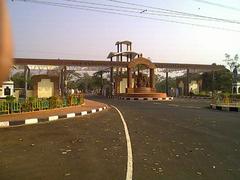Ladu Baba Temple Bhubaneswar: Visiting Hours, Tickets, and Travel Guide
Date: 04/07/2025
Introduction
Ladu Baba Temple, also known as Ladukeswar Temple, is a remarkable testament to Odisha’s rich spiritual and architectural legacy. Nestled in the Sarankul area of Nayagarh district, near Bhubaneswar, the temple embodies the distinctive Rekha Deula style of Kalinga architecture, with its curvilinear spire, intricate stone carvings, and symbolic iconography. Dating back to between the 9th and 13th centuries CE, the temple encapsulates both the historical depth and mythological lore of the region (omastrology.com; Trek Zone).
According to legend, the Shiva lingam at Ladu Baba Temple was relocated from Lanka to evade Ravana’s forces, infusing the site with a unique spiritual mystique. Despite the partial burial of its main shrine and the absence of the original principal deity, Ladu Baba Temple continues to serve as a vibrant center of worship, especially during Maha Shivaratri and other significant festivals (orissaguide.com).
For travelers, the temple’s free entry, welcoming atmosphere, and proximity to Bhubaneswar’s iconic temple circuit, including Lingaraj and Rajarani temples, make it a must-visit destination. This guide provides comprehensive insights into Ladu Baba Temple’s history, architecture, religious significance, practical travel information, and helpful tips to ensure a meaningful visit (traveltriangle.com; orissaguide.com).
Table of Contents
- History and Mythology
- Architectural Features
- Religious and Cultural Significance
- Visiting Hours & Ticket Information
- Accessibility & Travel Tips
- Nearby Attractions
- Preservation and Conservation
- FAQs
- References
History and Mythology
Historical Timeline
The origins of Ladu Baba Temple trace back to the medieval period of Odisha, with construction estimated between the 9th and 13th centuries CE (omastrology.com). Built during the flourishing era of Kalinga architecture under local dynasties, the temple’s style aligns with other iconic shrines that earned Bhubaneswar its reputation as the “City of Temples” (traveltriangle.com).
Mythological Associations
Local legends connect the temple to the Ramayana, with the belief that the Shiva lingam was brought from Lanka to protect it from Ravana. This mythological narrative also explains the current absence of a principal idol in the sanctum, setting Ladu Baba Temple apart from other Shiva shrines in Odisha (omastrology.com).
Architectural Features
Ladu Baba Temple exemplifies the Rekha Deula style, marked by a curvilinear spire and pancharatha plan (five projections on each side of the sanctum). The vimana (tower above the sanctum) covers approximately 6 square meters and, along with the porch, reflects the typical Kalinga school of temple design (omastrology.com).
Distinctive features include:
- Raha Niches: Three recesses for subsidiary deities, with only the western niche currently occupied by a four-armed Ganesh idol.
- Decorative Elements: The temple’s ornamentation is relatively restrained, focusing on artistic lintels with Navagraha figures and carved door jambs featuring leaf, human, and creeper motifs.
- Dvarapalas: Images of Shiva’s gatekeepers are present at the base of the door jambs, underlining the Shaivite affiliation.
Owing to partial burial and centuries of weathering, some structural elements are damaged or eroded, highlighting the need for ongoing preservation efforts.
Religious and Cultural Significance
Despite the absence of a central deity, Ladu Baba Temple remains a vital religious hub. Its inclusive ethos welcomes devotees regardless of caste or background. The temple is especially vibrant during Maha Shivaratri, when thousands gather for night-long prayers and rituals. Other festivals, such as Jhulan Yatra and Shitalashtami, showcase the region’s syncretic blend of Shaiva, Vaishnava, and Shakta traditions (orissaguide.com; odishadiscover.in).
Daily rituals include Mangala Arati, Abhishekam, and Deepa Arati. Community life flourishes around the temple, with music, dance, and festive processions forming an integral part of the cultural calendar.
Visiting Hours & Ticket Information
- Opening Hours: Daily from 5:30 AM to 1:30 PM and 4:30 PM to 8:30 PM (orissaguide.com).
- Entry Fee: Free for all visitors; donations are welcome.
- Photography: Permitted in the temple complex but generally restricted inside the sanctum. Confirm on arrival.
Accessibility & Travel Tips
How to Reach
- By Road: Located in Sarankul, Nayagarh, about 99 km from Bhubaneswar. Regular buses and taxis operate on this route.
- By Rail: Nearest major station is Bhubaneswar Railway Station.
- By Air: Biju Patnaik International Airport in Bhubaneswar is the closest airport (orissaguide.com).
On-Site Accessibility
- The temple complex is relatively compact but may pose challenges for visitors with mobility restrictions due to uneven surfaces and steps.
- Assistance is recommended for those with special needs.
Visitor Tips
- Best time to visit: October–March, for pleasant weather.
- Dress modestly and respect local customs, especially during rituals.
- Visit early morning or late afternoon for a quieter experience and optimal photography.
- Carry water, wear comfortable footwear, and be mindful of the temple’s sacred atmosphere.
Nearby Attractions
While visiting Ladu Baba Temple, consider exploring:
- Lingaraj Temple: An architectural marvel and major center of Shiva worship.
- Rajarani Temple: Renowned for its ornate carvings.
- Ananta Vasudeva Temple & Bindusagar Lake: Important sites within Bhubaneswar’s temple circuit.
- Nayagarh Historical Sites: Including Nayagarh Palace and local museums (traveltriangle.com; odishadiscover.in).
Preservation and Conservation
Ladu Baba Temple faces challenges from partial burial, weathering, and limited conservation infrastructure. Local authorities and community groups conduct regular maintenance and raise awareness about preservation (cultureandheritage.org). Responsible tourism—such as proper waste disposal, modest attire, and supporting local artisans—contributes to ongoing conservation efforts.
Frequently Asked Questions (FAQs)
Q: What are the visiting hours of Ladu Baba Temple?
A: 5:30 AM to 1:30 PM and 4:30 PM to 8:30 PM daily.
Q: Is there an entry fee?
A: No, entry is free; donations are appreciated.
Q: Are guided tours available?
A: Local guides may be hired nearby; check with local hotels or tourism offices.
Q: Is photography allowed?
A: Photography is permitted in the outer complex, but restricted inside the sanctum.
Q: How can I reach the temple from Bhubaneswar?
A: By road (bus/taxi), rail from Bhubaneswar station, or air via Biju Patnaik International Airport.
Q: What is the best time to visit?
A: October to March offers the most comfortable weather.
Visuals and Media

Interactive Map: Locate Ladu Baba Temple in Bhubaneswar
Conclusion
Ladu Baba Temple stands as a living heritage site where history, mythology, architecture, and devotion converge. Its open doors, inclusive atmosphere, and deep-rooted traditions offer visitors a unique opportunity to experience Odisha’s spiritual and cultural heartland. Whether you are a devotee, history enthusiast, or curious traveler, the temple promises an enriching journey into the legacy of Kalinga architecture and the enduring faith of its people.
For the latest updates, audio guides, and personalized travel tips, download the Audiala app. Explore related articles on Odisha’s temples and follow us on social media for cultural insights and event updates.
References and Further Reading
- Ladu Baba Temple Bhubaneswar: Visiting Hours, Tickets & Historical Guide (omastrology.com)
- Ladu Baba Temple Architecture and Visitor Guide: Visiting Hours, Tickets & Historical Insights (Trek Zone)
- Ladu Baba Temple, Nayagarh: Visiting Hours, Tickets & Cultural Significance (odishadiscover.in)
- Visitor Experience, Accessibility, and Conservation (orissaguide.com)
- Temples in Bhubaneswar: A Travel Guide (traveltriangle.com)








